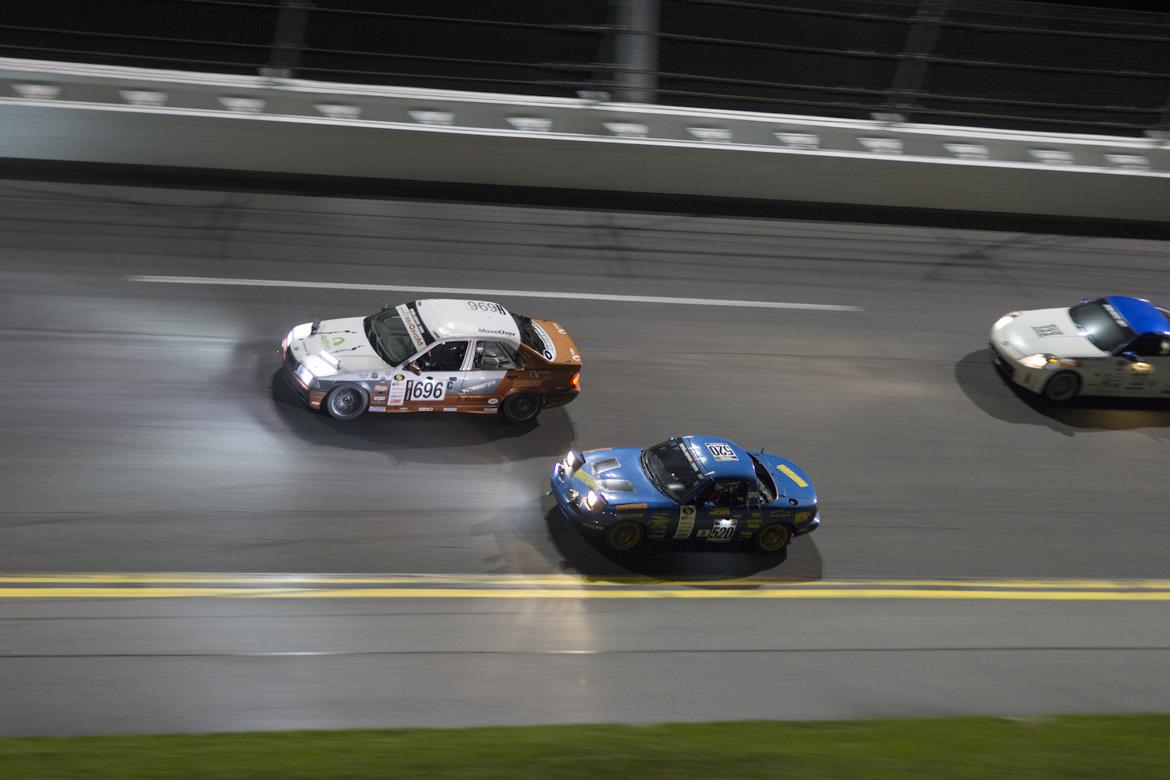My ears just perked up. Listening intently.


Endurance racing is hard. Doing it on a budget is even harder. Doing both while shooting for a podium finish? That’s nearly impossible, as we proved with our Miata.
After years of development, three turbos, four engines, and roughly a dozen depressing drives home from the track with a broken car on the trailer, we found success with our junkyard turbo setup: We finished second in class at ChampCar Daytona!
Then, well, we moved on. After all, we’re looking for good stories, not necessarily a good race car.
Once we’d sorted the car, reformed our team and earned a podium finish, we couldn’t just write boring stories about by-the-book races. We had two choices: Continue developing the car or get rid of it, and we didn’t want to do either. So we parked it.
After diverting our attention to our extremely budget-oriented Volkswagen Fox endurance racing car for a year or so, we turned our attention back to the Miata. Did we still like it? Absolutely. Did we think it could be faster, and produce a good story along the way? Definitely.
We pulled the Miata out of storage with new goals: Kick it up a notch, move away from low-buck racing, and go really fast. We’d trade 500-point ChampCar and 24 Hours of Lemons legality for a fighting chance at competitive AER or WRL showings, and use our VW Fox for the low-buck racing we still loved.
With our biggest limitation, the budget, removed, we grabbed a blank sheet of paper and started planning. What would our Miata look like in a perfect world? What were our pain points before? What would it need to beat on track?

After much deliberation, we came up with these goals:
Goals in hand, we started making calls and putting feelers out to our fellow friends and racers in the industry. Gradually a path emerged, with more and more arrows pointing to one answer: It was time for a V6 swap. The promise was simple: Two more cylinders, roughly the same weight (the Miata’s iron-block four-cylinder is traded for an all-aluminum V6) and nearly 300 horsepower. It would split the difference between our turbo four and a heavy, overpowered LS swap, and meet our goals perfectly.

There was one last question: Which all-aluminum, 300-horsepower V6? That’s right: There’re are two popular V6 swap kits on the market for early Miatas, and both use a commonly available all-aluminum V6.
The first, from Minitec, uses the Honda J series V6, which is the engine platform found in most of Honda and Acura’s sedan and SUV lineup. Minitec’s kit is designed around the 3.5-liter 2001-’03 Acura CL Type S or 2002-’04 Honda Odyssey engine, and includes the following parts. Retail price is $3950.
The second kit, from V8 Roadsters, uses the GM LFX engine, a direct-injected 3.6-liter V6 found in most modern GM products fitted with a V6, including the Camaro and Cadillac CTS. V8 Roadsters recommends using a 2012-’15 Camaro engine for their swaps. Retail price is $7995, and their kit includes the following:
Facts in hand, we decided to use the V8 Roadsters kit. Why? First and foremost, it used the entire Camaro driveline, replacing the relatively fragile Miata transmission and differential with parts from the V6 donor and significantly increasing the durability of the driveline.

The Minitec kit, in contrast, keeps the Miata transmission and differential. Put simply, we just didn’t see those Miata parts lasting behind 300 horsepower in an endurance racing setting.
There were other reasons, too: The V8 Roadsters kit was far more complete, basically including 90% of what we’d need to get the car running. The Minitec kit, in contrast, would require us to figure out our own cooling system, power steering and fuel system.
And we were curious about the LFX, as it seems like an engine with great potential that just hasn’t gotten much love in the enthusiast world. Shoutout to Ryan at Good-Win Racing here, too, since his stupid-fast LFX-powered HyperMiata inspired us greatly.



Decision made, we ordered the V8 Roadsters swap kit, then called a local salvage yard and ordered a Camaro engine and transmission, as well as a limited-slip differential from a Cadillac CTS. The salvage yard parts totaled just less than $1500, while the V8 Roadsters kit we ordered retails for $7995.
No longer a $500 race car, we found ourselves sitting in the shop with our trusty Miata on the lift and nearly $10,000 worth of parts next to it. After some serious ups and downs in its career, it was time for our Miata to receive engine number five. We’ll cover that in the next update.

There's also the Rocketeer kit with the Jaguar V6, FYI. I'm not sure if it's available in the US at the moment but it's pretty nicely done.
Keith Tanner said:There's also the Rocketeer kit with the Jaguar V6, FYI. I'm not sure if it's available in the US at the moment but it's pretty nicely done.
There was just some traffic on Miata.net that Rocketeer has discontinued kits as of 1/2020, and will only be building turnkey cars. As far as I know, there is no US turnkey builder.
LFX is probably the best choice for racing.
It would be worth your while to spend lots of time picking Ryan's brain... ![]()
Having followed the Hypermiata closely for several years, his results have been amazing, and he probably has more knowledge than anyone about making an LFX/Miata work on the track.
I'll be watching your progress with just as much interest!
You coulda done a 3400 for challenge money....
The lfx has a good 120 horse on it though. And swapping the differential makes a huge improvement.
Displaying 1-10 of 76 commentsView all comments on the GRM forums
You'll need to log in to post.